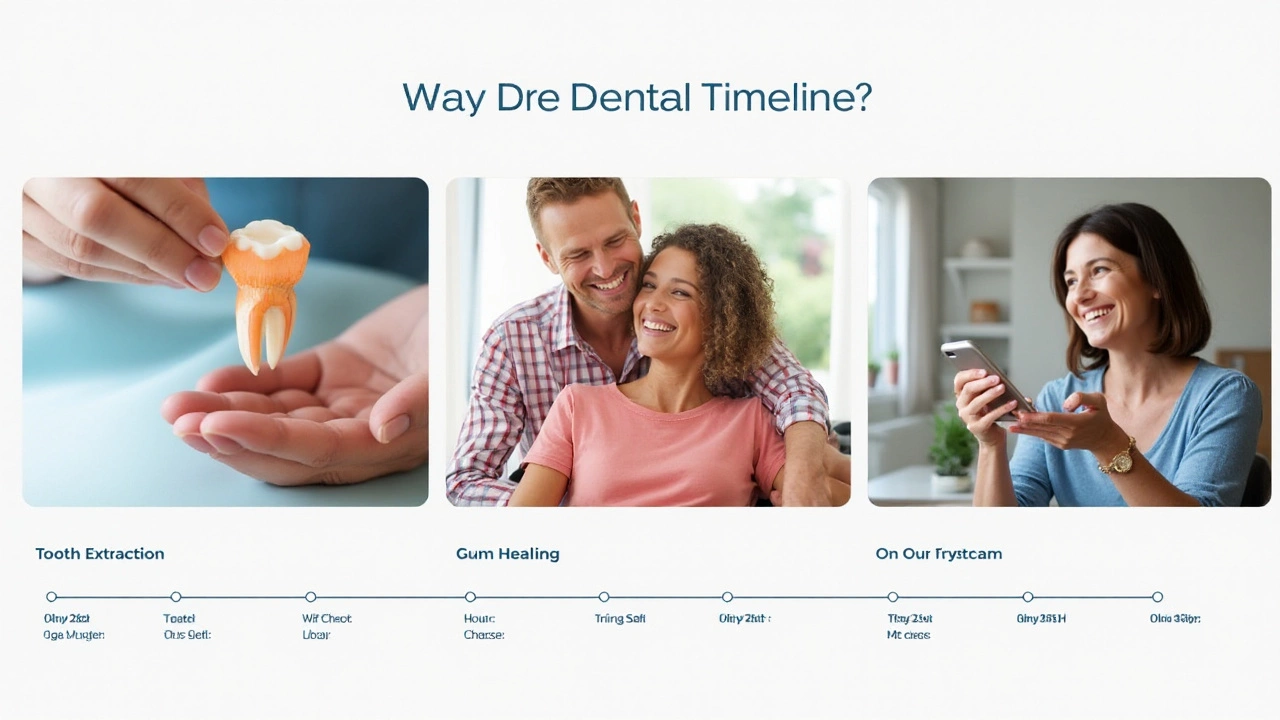In the realm of modern dentistry, dental implants stand out as a reliable solution for replacing missing teeth, offering a sturdy base for artificial ones that mimic the look and function of natural teeth. But as enticing as this sounds, many potential candidates wonder about the most significant step: the timeline. How long will they find themselves without teeth during this transformative journey?
For the uninitiated, the process begins with an evaluation of oral health, ensuring the mouth is prime for implant placement. Following this, an intricate dance of appointments, healing, and sometimes even additional procedures like bone grafting, kicks off. Fear not, though; temporary teeth solutions exist, ensuring that life keeps its smile even while awaiting the grand reveal.
As with all dental procedures, the path to a full set of implant-supported teeth varies from individual to individual, hinging on factors such as bone density and overall health. Yet, understanding these steps isn't just about managing expectations—it's also about preparing for a new, toothy chapter in life.
- Introduction to Dental Implants
- Initial Consultation and Planning
- The Implant Procedure and Healing Period
- Temporary Solutions While Waiting
- Factors Influencing Timelines
Introduction to Dental Implants
Dental implants have revolutionized the way we approach tooth loss, offering a durable and aesthetically pleasing replacement option that maintains both function and appearance. At their core, dental implants serve as artificial tooth roots, embedded into the jawbone to support crowns, bridges, or dentures. This transformative technology echoes the natural tooth setup, providing stability and strength unmatched by any other prosthetic options available today. While initially developed in the 1950s by Swedish orthopedic surgeon Per-Ingvar Brånemark, the concept has advanced significantly, capturing the interest of millions worldwide.
The procedure involves several stages, starting with the meticulous planning and evaluation of the patient’s oral health. Advanced imaging techniques, such as 3D CT scans, allow dental professionals to map out precise implant placement, a crucial step for achieving successful outcomes. Once the plan is laid, the implant, typically a titanium post, is surgically inserted into the jawbone. Over time, a process called osseointegration takes place, where the bone grows and fuses with the implant. This unique healing process is fundamental to the implant's long-term success and function.
"Dental implants have a success rate of up to 98%, offering a dependable and permanent solution for missing teeth," notes the American Dental Association. This statistic highlights the reliability and efficiency of teeth replacement through dental implants, making them a preferred choice for many patients.Post osseointegration, an abutment is attached to the implant, serving as a connector for the prosthetic tooth. Finally, the custom-made dental crown, crafted to match the color and shape of surrounding teeth, is affixed, completing the restoration. Unlike dentures or bridges that may require periodic adjustments, implants boast longevity and require minimal maintenance beyond standard oral hygiene practices.
For those considering dental implants in the UK, several factors must be weighed, including costs, healing time, and potential need for additional procedures like bone grafts. Bone density can often dictate the complexity of the procedure—strong, healthy bone ensures better outcomes. One considerable advantage of implants over other methods is their ability to preserve facial structure and prevent bone loss, which naturally occurs when teeth are missing. The more teeth lost, the more the bone recedes, altering facial appearance significantly over time.
Embracing this modern marvel hinges on individual suitability, as not everyone may qualify for traditional implants. Alternatives like mini-implants or all-on-four solutions offer viable options for those with limited bone availability. Importantly, consultation with experienced dental practitioners is essential to determine the best personalized approach. As dental technology continues to evolve, the possibilities for comprehensive and accessible solutions in UK dental care grow, offering hope and renewed confidence to those affected by tooth loss.
Initial Consultation and Planning
Embarking on the journey of receiving dental implants starts with a comprehensive initial consultation, a crucial step that sets the stage for the entire process. At this appointment, patients meet with their dental professional, typically an oral surgeon or prosthodontist, who will conduct a full assessment of their oral health. This assessment includes both a visual examination and various imaging studies such as X-rays or 3D scans. These tools allow the practitioner to evaluate the patient’s bone density and structure, which are critical in determining suitability for implants. Many practitioners often emphasize that the initial consultation is not just about evaluation—it’s an opportunity for patients to vocalize their expectations and concerns, setting realistic goals based on their oral health and lifestyle.
During this pivotal visit, the dental specialist will explore the patient’s medical and dental history to identify any factors that might impact the implant procedure. Individuals are encouraged to provide a comprehensive disclosure of their medications, allergies, and underlying health conditions, as these can influence healing and procedural success. For instance, conditions like uncontrolled diabetes or habits such as smoking may pose risks that require careful management throughout the implant journey. Armed with this information, the dental professional can tailor a treatment plan that aligns with the individual’s unique needs.
An integral part of planning dental implants involves discussing the timeline. Patients often express concern over the period they may have to endure without their natural teeth. Dental practitioners outline the various stages, such as tooth extraction, healing periods, and the eventual placement of the implant. This discussion is critical in helping patients understand that while some stages might take time, temporary solutions are available to maintain aesthetics and function. It’s not uncommon for dental professionals to reference insights from renowned specialists. As Dr. Marko Vujicic, Chief Economist & Vice President of the ADA Health Policy Institute said,
"Understanding the procedure timeline helps patients align their expectations with reality and makes the journey less daunting."
For individuals with insufficient bone density, a concept known as bone grafting may arise during planning. Bone grafting enhances the existing bone volume, ensuring a sturdy foundation for implants. This additional procedure might extend the treatment timeline but significantly increases the success rate of implants. The dental professional will discuss various graft materials, ranging from natural bone harvested from another part of the patient’s body to synthetic options, weighing the pros and cons of each. Finally, discussions around cost and financing options are vital components of this initial planning stage. Dental implants can be a substantial investment, and having a clear understanding of the financial commitment upfront helps patients make informed decisions. Many dental practices provide financing plans or partner with companies that offer manageable payment options, making this transformative procedure more accessible.

The Implant Procedure and Healing Period
The journey to obtaining dental implants involves a meticulous and carefully planned process, beginning with the implant procedure itself. This typically starts with the surgical placement of the titanium post directly into the jawbone. Think of this post as the root of your new artificial tooth. While the idea of surgery might sound daunting, the procedure is often performed under local anesthesia, ensuring comfort and very minimal pain. The true magic happens in the months following this initial procedure, referred to as osseointegration, where the jawbone grows around and firmly anchors the post. This phase is critical as it establishes the foundation that allows the implant to function like a natural root.
Though it might sound extensive, the healing period post-implant is a testament to your body's remarkable ability to adapt and heal. Most patients find themselves back to their regular routine shortly after the surgery, albeit with certain care guidelines. These typically involve maintaining oral hygiene meticulously and avoiding hard foods that might disturb the healing site. This period is crucial as it allows maximum bone support and stability for the dental implants. While the timeline can vary depending on individual health circumstances, most patients report a healing period of three to six months before they can move onto the next exciting phase of getting the artificial teeth fitted.
While patience is key, temporary solutions are available to ensure you're not left without teeth during this healing period. Options such as a temporary crown or bridge can fill the gaps temporarily and maintain your smile while you await the permanent replacement. The investment of time in this phase pays off, as a properly integrated dental implant can last a lifetime, offering not just a cosmetic solution but a practical one that enhances functions such as chewing and speaking. An insightful report from the British Dental Association suggests that consistent oral hygiene and regular dental check-ups significantly contribute to the longevity of implants, emphasizing an average success rate of 95% at ten years.
"Dental implants, on the whole, represent one of the greatest advances in dentistry for both function and aesthetics, providing a durable solution to missing teeth," notes Dr. Jane Young from the British Academy of Implant Dentistry.
The waiting period after the surgery is not just a time of physical healing, but also a chance to adapt mentally to the changes and enhance one’s routine to accommodate these new additions. It's during this time that individuals often build confidence in their new smile, knowing that it's firmly supported by the most advanced techniques modern dentistry has to offer. As you prepare for the final fitting of new teeth, embracing good oral hygiene habits becomes second nature, carving out a path towards a brighter, healthier future with teeth replacement.
Temporary Solutions While Waiting
The journey towards a radiant smile with dental implants often includes a phase devoid of permanent teeth, albeit temporary. During this interim, when the implants are healing and integrating with the jawbone—a phase known as osseointegration—many patients ponder how to navigate daily life without their pearly whites intact. Fortunately, modern dentistry offers a spectrum of temporary solutions that ensure your social confidence remains unshaken. One such solution is the use of temporary dentures, which can be crafted and fitted before tooth extraction, provided your dentist offers such an option. These dentures can serve as a placeholder, maintaining the integrity of your facial aesthetics without compromising comfort.
Another viable temporary option comes in the form of a dental flipper, a lightweight, removable alternative resembling a retainer, except it has one or more prosthetic teeth attached. Its practicality lies in its ability to be easily inserted and removed, making cleaning a breeze while adding the convenience of quick adaptation to changes in the mouth as it heals. Some patients favor flippers for their affordability and simplicity, though it's worth considering their potential drawbacks, such as fragility compared to other options. Recent innovations have introduced a variant known as Essix retainers, transparent aligner-like holders that allow for a more natural appearance, albeit less robust than traditional flippers.
Beyond temporary dentures and flippers, there is a method which crafts temporary crowns or bridges, secured to adjacent teeth for stability. This is largely contingent on the number of missing teeth and the desired aesthetic outcome. A temporary crown spans the gap, sitting tightly on the implant site. UK dental care practices often make use of these devices to mimic the eventual appearance of the final implant-supported teeth, thus helping patients transition smoothly into the final stages. An important consideration, however, is the durability of these crowns, requiring diligent care to prevent damage during use. "Temporary crowns serve as a critical step to ensuring the success of the final, permanent restoration," shares Dr. Abigail Clarke, a respected UK-based prosthodontist.
In some instances, patients decide on not having temporary replacements at all, opting for the natural healing process to set its course. Although this is a personal choice, it’s worth discussing with your dental professional to understand the merits and demerits, especially if aesthetic or psychological concerns weigh heavily on your decision-making. The choice is highly personal, favoring those who prioritize quicker osseointegration even if it means bearing the gap for a brief period.
Ultimately, the key to thriving during this transitional period is open communication with your dental professional to tailor a solution that meets your needs without compromising the eventual success of the implants. With diligent care and a clear understanding of options, the wait can transform from a potential source of anxiety into a thoughtfully navigated journey toward reclaiming a full smile.

Factors Influencing Timelines
Embarking on the journey of dental implants is not a one-size-fits-all approach. The timeline from start to a gleaming finish is influenced by a myriad of personal and procedural factors, each intertwining to create a unique path for every patient. One crucial factor is the individual's oral health status at the onset of the procedure. If gums are inflamed or if there are signs of infection, preliminary treatment might be needed to ensure a healthy environment for the implants. This initial step can add weeks or even months to the process, but it's essential for an enduring and stable result.
Another key aspect is the bone density in the jaw, which plays a pivotal role in determining both the feasibility and timeline of dental implants. Patients experiencing bone loss may require bone grafting procedures before implants can be placed securely. This step is vital for those whose bone structure cannot naturally support an implant, and it can add several months to the overall timeline as grafts need time to heal and integrate with existing bone tissue.
As Dr. Sarah Thompson, a renowned dental practitioner, states: "The foundation of the jawbone is akin to the foundation of a house. A stable base ensures longevity and resilience in any structure built upon it."
It's also worth considering the specific type of implant methodology chosen, as options like immediate load implants are designed to allow temporary crowns to be placed on the same day as implants. However, not everyone is a candidate for such speedy solutions, and extensive diagnostic evaluations are essential to make the right choice. Implant material and design – typically titanium or zirconia – can influence integration time and are often selected based on individual health profiles and aesthetic goals.
The experience and expertise of the dental surgeon can't be understated. Experienced professionals often streamline procedures effectively, reducing wait times between steps. Finally, personal factors such as lifestyle choices, including smoking or unchecked diabetes, can prolong healing times. Post-surgery care also influences recovery, with rigorous oral hygiene and regular follow-up visits ensuring everything stays right on track.
Patient Involvement
Patients play a significant role in the timeline of their teeth replacement. Committing to dental health before, during, and after the procedure is critical. Proper nutrition, abolishing smoking, and regular dental checkups are key elements for ensuring a smooth process. It's a collaboration between the patient and their healthcare provider, blending guidance with personal diligence to reach a successful outcome. Embracing these steps can lead to not only a faster timeline but also peace of mind and a lifetime of healthy smiles.
